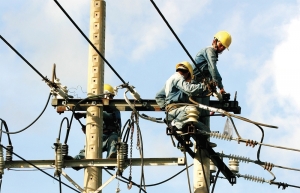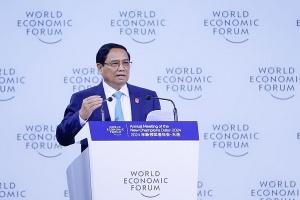Importance stressed over power system
 |
| Vietnamese leaders have admitted that the move from fossil energy to renewables is slow going, Photo Le Toan |
In a fresh report posted on its website, the ministry (MoIT) stated that the national electricity system will “provide enough electricity for national socioeconomic development and demand of the public and enterprises”.
In the first seven months of this year, the total output of domestically produced and imported electricity is estimated to hit 174.1 billion kWh, which is 11.7 per cent higher than that in the same period last year.
In 2023, the total output of domestically produced and imported electricity reached 280.6 billion kWh, up 4.56 per cent on-year. It is forecasted that the economy’s total demand for power this year will increase by about 9.6 per cent on-year, meaning a big burden for the electricity industry.
However, the MoIT cited Vietnam Electricity (EVN) as having reported that in the remaining months of this year, the electricity supply for the public and domestic production will be ensured.
But EVN also admitted that electricity demand will continue to increase at a high level until the year’s end, while the national power system’s reserve capacity is forecast to remain low until the end of October. In the case of of high load combined with unfavourable factors of the power system, there is still a potential risk of having to adjust load during peak hours.
The MoIT said it will continue closely monitor and supervise the supply of fuel such as coal, gas, and oil, and the performance of different electricity sources. It will also direct groups and corporations, as well as related units, to “seriously implement solutions” to provide sufficient power for the economy in the remaining months of this year.
Urged by the government, the MoIT is now working with the ministries of transport, planning and investment, and construction to speed up the building of the 500kV transmission line project from Quang Trach to Pho Noi, which must be put into operation in early September.
Considered a key initiative in the electricity industry, this 519 kilometre project is costing $931.5 million and is funded by the National Power Transmission Corporation under EVN. It has a scale of two circuits of 500kV transmission line.
“For power grid projects currently under construction for power connection and support hydropower sources and electricity importation, the MoIT will focus on working with localities to solve problems in site clearance compensation, and at the same time urge contractors to speed up progress,” the ministry stressed.
At present, Vietnam is making efforts to create improvements for the development of renewable energy as part of its international commitment made in 2021 to achieve net-zero emissions by 2050.
The government also approved the nation’s Power Development Plan VIII (PDP8) to 2030, with a vision to 2050. Last week, it requested the MoIT to “effectively implement” the plan.
A decision approving a roadmap for the implementation of the PDP8 has been released, reflecting Vietnam’s commitment to accelerating the transition from conventional fossil fuels to cleaner and renewable energy sources, addressing environmental concerns, reducing greenhouse gas emissions, and aligning with global sustainability targets.
By 2030, Vietnam aims to diversify its energy mix significantly. According to the approved roadmap, the country plans to bolster its capacities in thermal, liquefied-natural-gas thermal, and coal-fired thermal power plants to 14,930MW, 22,400MW, and 30,127MW, respectively.
Meanwhile, the focus will be on ramping up renewable energy sources, with capacities for offshore wind, onshore wind, and biomass power reaching 6,000MW, 21,880MW, and 1,088MW, respectively. Additionally, electricity generated from waste is expected to contribute 1,182MW, alongside an additional capacity of rooftop solar power set at 2,600MW.
To facilitate efficient energy storage, a total capacity of 300MW for battery storage is also planned.
Last December, Vietnam announced its resource mobilisation plan for the Just Energy Transition Partnership, which has been since then fuelled by the international community pledging to accompany the country in its journey. The International Partners Group has committed to mobilise significant financing to support Vietnam towards this goal: At least €15.5 billion ($16.8 billion) in public and private finance in the next few years.
“However, the transformation from fossil energy to renewable energy and new energy sources in order to materialise the government’s international commitment to achieve net-zero emissions remain at a slow pace,” the MoIT admitted in its report.
It is estimated that by 2022, coal-fired power plants accounted for 32.5 per cent in the Vietnam’s energy mix, while the PDP8 also calls for the gradual transition of such plants to alternative forms of energy.
However, according to the United Nations Development Programme, in future, detailed conversion plans must be prepared for many such plants, and discussed between owners and other stakeholders.
 | DPPA streamlining closer to acceptance The business community has asked for relaxed regulations for large customers to be able to buy and sell electricity directly. |
 | Durable electricity supply to be ensured Escalating power consumption has sparked an imperative to boost construction of a transmission line and simultaneously mobilise maximum capacity from coal-fired and gas-to-power plants to ensure adequate electricity supply this summer. |
 | Vietnam's PM assures no energy shortages in 2024 at WEF discussion Vietnamese Prime Minister Pham Minh Chinh chaired a discussion with Professor Klaus Schwab, founder and executive chairman of the World Economic Forum (WEF), and around 20 leaders of major WEF corporations on June 26 in Dalian, China. |
 | Total power capacity by 2030 In Decision No 262/QD-TTg dated April 1, 2024, the Prime Minister approved the implementation plan for the National Power Development Master Plan in the 2021-2030 period with a vision to 2050. |
What the stars mean:
★ Poor ★ ★ Promising ★★★ Good ★★★★ Very good ★★★★★ Exceptional
Related Contents
Latest News
More News
- Heavy industries set for pilot greenhouse gas quotas (December 25, 2025 | 10:00)
- Swedfund invests in MSME growth and climate action in Vietnam (December 19, 2025 | 11:42)
- GreenYellow brings solar energy to light up remote schools in Tuyen Quang province (December 19, 2025 | 08:00)
- Charge+, Grab partner to develop EV charging network in Vietnam (December 18, 2025 | 17:11)
- Linking sci-tech and innovation to Vietnam’s net-zero future (December 18, 2025 | 14:31)
- Driving double-digit growth through green and circular transformation in Vietnam (December 17, 2025 | 09:00)
- Standard Chartered and ACCA deepen collaboration to develop Vietnam’s talent for a sustainable future (December 15, 2025 | 18:18)
- Schaeffler reports strong early output from Dong Nai solar project (December 12, 2025 | 15:16)
- Forestry conference highlights biodiversity and sustainability goals (December 09, 2025 | 13:35)
- Home Credit honoured among top 10 sustainable companies in trade and services (December 09, 2025 | 12:18)

 Tag:
Tag:





















 Mobile Version
Mobile Version